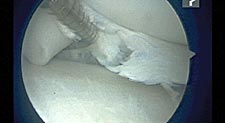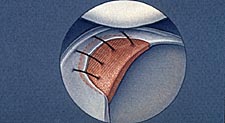Surgeons weigh benefits of collagen for meniscal repair
Proponents tout regenerative properties, while critics cite a lack of convincing research.
Meniscal transplantation remains a difficult option given that patients can wait six months for donor tissue. Such delays, plus the need for stronger repairs, have led researchers to explore using collagen as an alternative.
|
|
Current studies focus on using the technology in partial meniscectomy, said Kevin R. Stone, MD, of The Stone Clinic in San Francisco.
“In many people, loss of segmental portions of the meniscus, especially in the medial side, lead to symptoms, but it may take years for those symptoms to appear,” he told Orthopedics Today. “So right now, these implants are being studied in people who have become symptomatic after partial meniscectomy. They are not indicated for total meniscus replacement, where a complete meniscus allograft would currently be used.”
Since collagen may take up to a year to mature, Stone Research Foundation researchers are planning studies to add mesenchymal stem cells and other growth factors to templates in order to hasten regeneration.
“We need to speed up the healing and remodeling of these templates, as well as allografts, xenografts and autografts, before the patients destroy them with sports activity,” Stone said.
Growth in partial repairs
Studies using collagen in partial repairs show “no harm” from the procedures and successful tissue regeneration, he said. In a previous study initiated in 1991, Stone implanted the CMI (ReGen Biologics Inc.), formerly known as the Collagen Meniscus Implant, in 10 patients with meniscal tears. “In that group of patients, pain relief occurred and regeneration of the meniscus was documented by second-look arthroscopy and biopsy, confirming that there was regeneration of meniscal tissue, resorption over time of the collagen scaffold and no evidence of rejection,” he said.
Stone’s colleagues — J. Richard Steadman, MD, and William Rodkey, DVM — repeated the research with the CMI in Vail, Colo., and in a worldwide clinical trial. The results also showed tissue regeneration.
“Three separate studies have confirmed that the meniscal tissue can be regrown in segmental defects,” Stone said. “In the future, when the results are more widely known, I suspect that meniscus scaffolding and meniscus replacement will become the standard of care at the index operation.” The FDA has not yet approved the CMI for clinical use.
|
Courtesy of Andrew S. Levy |
Better scores after implantation
In a study earlier this year reported in Arthroscopy, Steadman and colleagues found a significant improvement in Lysholm scores (P=.045) and average Tegner activity scores (P=.001) following collagen meniscus implant procedures. In that study, a single surgeon implanted the meniscus in eight patients and researchers performed follow-up examinations at an average 5.8 years. Investigators noted that patient pain scores decreased 12 points (on a 100-point scale) and found 69% defect filling on second-look arthroscopies. Histological findings also revealed three patients with fibrocartilage, the authors wrote in their abstract.
Implanting collagen devices requires removal of additional meniscal tissue. And while many surgeons voice concerns about resulting damage, many of them may not be warranted, Brian J. Cole, MD, of Rush University Medical Center in Chicago, told Orthopedics Today.
Cole bases his claim on a study he and his colleagues performed creating meniscal tears in 10 cadavers and examining contact forces across the tibial femoral joint after implantation. “We found that when it gets back to the periphery, at any point, at least 1 cm to 1.5 cm, that the knee biomechanically, when measuring contact forces, starts to look like a completely meniscectomized knee,” he said. The study is under review and awaiting publication.
Not for complete meniscectomy
|
|
|
|
Courtesy of Kevin R. Stone |
Despite promising results for partial meniscectomy, Stone cautions that surgeons should not use collagen in cases with significant meniscus loss.
“Contraindications for the laboratory-formed implants are a complete meniscectomy, significant biomechanical deformity and inflammatory arthritis, because the environment is degradative or unsupportive of regrowing meniscal tissue,” he said.
Stone’s new research includes using bone-patella tendon-bone from swine to create new ligaments for ACL reconstruction. This work is sponsored by CrossCart Inc. The work has received an FDA approval for a wide trial comparing it to allograft for ACL reconstruction. He hopes the results will also prove applicable for meniscal replacement in the future.
“We are currently working on providing a whole range of xenograft tissue devices from pigs focusing on a new technology that specifically removes the primary antigen that causes rejection when animal tissues are transplanted into humans,” Stone said.
Coupling new technologies with growth factors may improve meniscal reconstructions using collagen over time. “But even today, the scaffolds are better than doing nothing and hoping for the best,” Stone said.
A call for caution
While some surgeons have great enthusiasm for collagen-based meniscal repair, others urge restraint. They cite the low level of research, unclear outcomes and questionable corporate motives as cause for caution.
“In terms of the use of collagen scaffolds in meniscal repair, I have chosen not do this on humans at the present time until I see better data,” Andrew S. Levy, MD, the director of the Cartilage Restoration Center of New Jersey, told Orthopedics Today. “I think there are certainly studies that have occurred in animals showing that while you can put things into them that look like a meniscus, they seem to very rarely function like a meniscus.”
Levy cites “industrial rush” — not clinical evidence — for prompting collagen application in partial replacement. After partial meniscectomy, few patients with intact cartilage report symptoms, while most are pain-free. In addition, long-term Scandinavian studies comparing outcomes after partial meniscectomy showed similar arthritic risks between control and treatment groups, he said.
“I’m not sure that we have shown that putting a partial meniscal replacement in [a patient] will change the outcome for the patient, given the fact that we’ve increased the magnitude and cost of the surgery,” Levy said.
What’s at fault?
In symptomatic patients, researchers remain uncertain that the meniscus is the culprit. Research by Laurence D. Higgins, MD, and colleagues in Durham, N.C., suggested that knee alignment “is probably the bigger issue than the small portion of the meniscus that they lose,” Levy said. “[So], in replacing a portion of the meniscus that’s lost, we’re not sure what our real problem is.”
Levy also remains cautious about using collagen for significant meniscus loss. In these symptomatic patients, he performs a meniscal transplantation. The procedure increases function and reduces pain in 94% of cases, he said.
“I think the use of a collagen entire replacement has got to be shown clearly to be able to demonstrate the same improvements that are being shown with a meniscal transplant,” Levy said.
Strengthening repair
Still, conventional meniscal procedures such as transplantation and repair are far from perfect.
“Meniscal repair with an ACL reconstruction is about 95% successful, but in isolated repair, the success rate in the long-term studies is approximately 60%-70%” of tears that would meet normal criteria for repair, Levy said. Similarly, the prophylactic ability of transplantation against arthritis remains uncertain.
Therefore, research should focus on enhancing repair and identifying an alternative replacement for standard transplants, identifying rather than using collagen to replace part of the meniscus, he said.
According to Levy, there is a new material that the FDA has just cleared from a company called the Pegasus Corp., which “actually has some interesting properties of sterilization that do not break the mechanical structure. This utilizes equine pericardium and has great [potential] to allow for strengthening of the repair. But it is very early,” Levy said.
He added: “In essence to me [with] the use of partial replacements, I’m not sure if we’re dealing with the essence of the problem or just trying to find a use for something that has been made. On the other hand, the application of these devices to strengthen meniscal repair — we have a need to achieve that.”
Dr. Stone has a financial interest in ReGen Biologics and CrossCart.
For more information:
- Steadman JR, Rodkey WG. Tissue-engineered collagen meniscus implants: 5- to 6- year feasibility study results. Arthroscopy. 2005;21:515-525.
- Stone KR, Steadman R, Rodkey WG, et al. Regeneration of meniscal cartilage with use of a collagen scaffold. Analysis of preliminary data. J Bone Joint Surg Am. 1997;79:1770-1777.

![Kevin R. Stone, MD [photo]](/~/media/images/news/print/orthopedics-today/2005/10_october/stone_70_90_4063.jpg)




